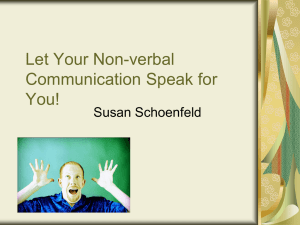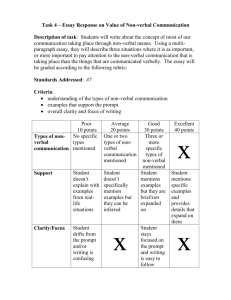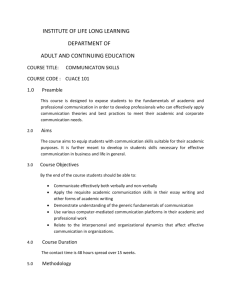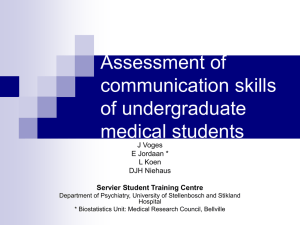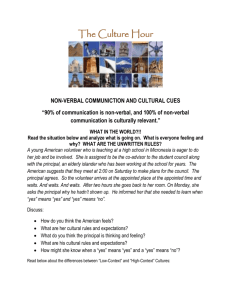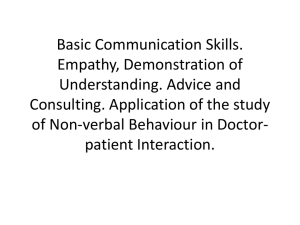Communication in health and social care
advertisement
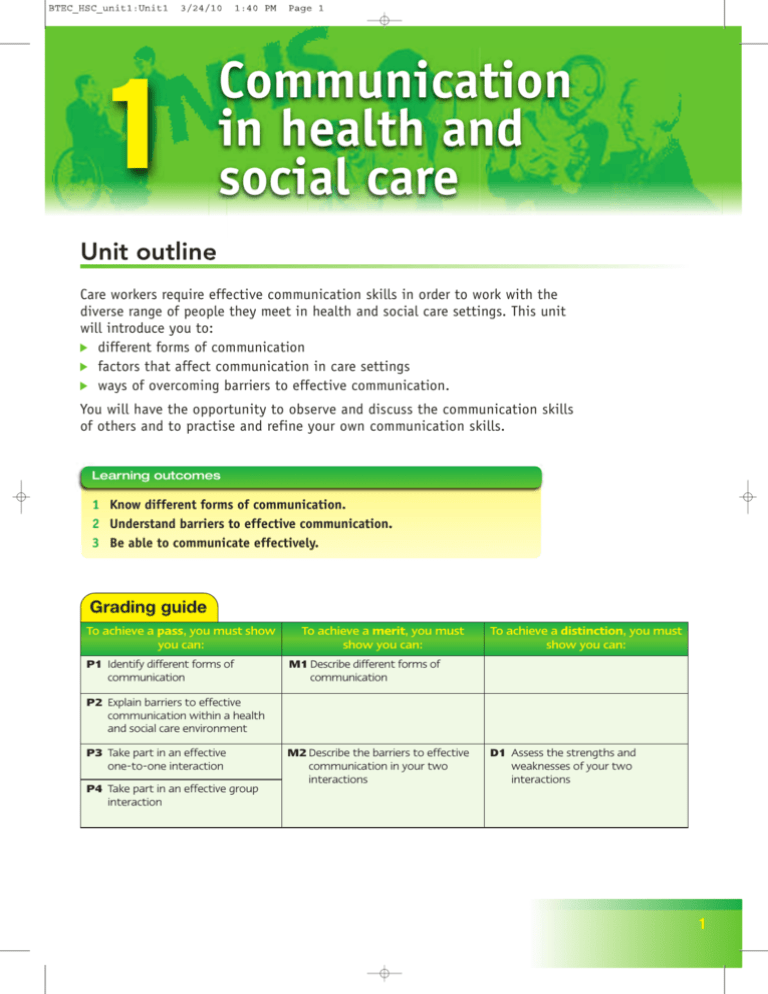
1 Communication in health and social care Unit outline Care workers require effective communication skills in order to work with the diverse range of people they meet in health and social care settings. This unit will introduce you to: different forms of communication factors that affect communication in care settings ways of overcoming barriers to effective communication. You will have the opportunity to observe and discuss the communication skills of others and to practise and refine your own communication skills. Learning outcomes 1 Know different forms of communication. 2 Understand barriers to effective communication. 3 Be able to communicate effectively. Grading guide To achieve a pass, you must show you can: P1 Identify different forms of communication To achieve a merit, you must show you can: To achieve a distinction, you must show you can: M1 Describe different forms of communication P2 Explain barriers to effective communication within a health and social care environment P3 Take part in an effective one-to-one interaction P4 Take part in an effective group interaction M2 Describe the barriers to effective communication in your two interactions D1 Assess the strengths and weaknesses of your two interactions 1 Topic 1.1 Forms of communication Getting started This topic introduces you to the forms of communication used by health and social care workers and the contexts in which they are used. When you have completed this topic, you should: ■ be able to describe and explain the communication cycle ■ know about one-to-one, group, formal and informal communication in health and social care settings ■ be able to describe a range of different forms of communication used by health and social care workers. Key terms Decode: make sense of the information contained in a message Empathy: understanding and entering into another person’s feelings Formal communication: official or correct forms of communication Informal communication: doesn’t stick to the formal rules of communication (e.g. a casual, relaxed conversation, written note or text message) Makaton: a system of communication using simple hand signs, which is used by people with language and learning difficulties Non-verbal communication: forms of communication that do not use words (e.g. body language) Objects of reference: objects that have a particular meaning for a person (e.g. a special ring or ornament) Symbol: an item or image that is used to represent something else Verbal communication: forms of communication that use words (e.g. conversation) The communication cycle Communication is about making contact with others and being understood. It involves people sending and receiving ‘messages’. We all communicate, or ‘send messages’, continuously. Figure 1.1 describes the communication cycle. It shows that a communication cycle occurs when: 2 1 Idea occurs Message coded Message 3 sent 1. A person has an idea. 2. They code their ‘message’ (using words or non-verbal means). 3. They send their message to someone else (e.g. by speaking). 4. A second person then receives the message (e.g. by hearing what has been said or by noticing non-verbal communication). 5. The second person decodes the message. 6. The message is understood. 2 Message 6 understood Message decoded 5 Message received Figure 1.1 The communication cycle 4 1 Communication in health and social care Once the original message has been understood, the cycle will be repeated if the second person replies or responds. Repetitions of the communication cycle are an essential part of our relationships, and occur every time we have a conversation. Case study Charlie is 2 years of age. He enjoys helping his mum in the kitchen when she is making a meal. When she says, ‘Can I get some fruit for you Charlie?’, he puts his arms in the air, says ‘me, me’ and smiles at her. His mum responds by picking him up and saying, ‘Okay, you take something yourself this time, Charlie’. 1. How does Charlie’s mum communicate with him in this example? 2. How does Charlie communicate non-verbally with his mum in response to her question? 3. Describe how a cycle of communication occurs in this example. Forms of communication Care workers use different forms of communication during their working day (or night). These include the verbal communication skills of talking and listening, and various forms of non-verbal communication, such as touch, eye contact and facial expression. A care worker has to use both of these forms of communication when they: give or receive information about the care that is being provided for an individual provide emotional support to a individual or member of their family carry out an assessment of an individual’s care needs. Verbal communication Verbal communication occurs when one person speaks and another person listens. Care workers need a range of verbal communication skills to: respond to questions find out about an individual’s problems or needs contribute to team meetings break bad news provide support to others deal with problems and complaints. The communication cycle demonstrates that effective verbal communication is a two-way process – speaking and listening must occur. Listening is much harder than speaking and there is more to this skill than just waiting for the other person to stop talking. Over to you! Are you a good listener? Think about what you do when you really listen to another person. Try to identify the skills and qualities needed for effective listening. 3 1.1 Forms of communication Non-verbal communication As well as communicating through speech, people use a variety of forms of non-verbal communication. Some of these are referred to as body language. This is because they involve the individual using their body and appearance to communicate in some way. For example, a care worker’s behaviour, appearance and attitude send ‘messages’ to people who receive care (as well as to colleagues) about what they think and feel. Similarly, a person’s body language may tell a care worker that they are uncomfortable or experiencing pain even when they say, ‘I’m okay’. Non-verbal communication is a channel of communication that is ‘always on’. Figure 1.2 Forms of non-verbal communication Non-verbal communication What does it involve? Examples Facial expression Movements of the face that express a person’s feelings • Smiling • Frowning Touch or contact Physically touching or holding a person • Holding someone’s hand • Placing a hand on a person’s arm or shoulder to reassure them Gestures Deliberate movements of the hands to express meaning • Thumbs-up gesture to show agreement or pleasure • Shaking a fist to show anger or aggression Proximity The physical closeness between people during interactions • Being physically close to someone may be reassuring and may be seen as accepting the person. • On the other hand, it might make the person feel uncomfortable and threatened. • People need less personal space when they have a close, trusting relationship. Eye contact Looking another person directly in the eyes • Short or broken eye contact can express nervousness, shyness or mistrust. • Long unbroken eye contact can express interest, attraction or hostility. Signs, symbols and objects of reference Care organisations sometimes use signs and symbols to communicate with the people who use their premises. Signs and symbols are graphical ways of communicating essential information. Using images enables people who cannot speak or understand a spoken language, such as English, to communicate. Objects of reference are items such as toys, clothes, jewellery or other everyday objects that have a special meaning for somebody. For a child, a cuddly toy may represent comfort and safety. An older person may treasure their photographs because they represent and provide memories of family, friends and relatives. Objects of reference, such as photos or toys might be used by a teacher to stimulate communication and interaction with individuals with learning disabilities. 4 Over to you! When you have a chance, watch a group of people talking or socialising together. Observe the way they use their bodies to communicate. Try to work out what they are ‘saying’ non-verbally. 1 Communication in health and social care Technological aids Technological aids, such as electronic communicators, hearing aids and videophones are designed to help disabled people who have difficulty sending or receiving ‘messages’ as part of the communication cycle. Many non-disabled people now also use technology in the form of mobile phones, text messaging and emails to communicate with others. Websites such as Facebook, Twitter and Bebo are also examples of technological aids that promote communication between people. Human aids These include people who work as: interpreters, who listen to a person speak in one language and then communicate what they have said to a second person in a different language translators, who translate what is written in one language into a second language (e.g. English to Hindi) signers, who use forms of sign language to communicate what has been said or written into a sign language, such as British Sign Language or Makaton. Alternative forms of communication People who are unable to communicate in conventional ways sometimes use alternative communication systems to send and receive messages. For example: People with visual impairments often use their sense of touch to read documents written in Braille. This uses a series of indentations made by a special stylus on one side of paper. The combinations of indentations represent letters that can be touch-read by people who understand the Braille system. People with hearing impairments or learning disabilities sometimes use lip reading and sign language to communicate. Sign language systems include finger spelling (dactylography), British Sign Language and Makaton. A range of graphical signs and symbols are also widely used in health and social care settings to warn people of health and safety hazards, provide directions and give information to people who are unable to speak or understand English. 5 1.1 Forms of communication Contexts of communication The two main contexts in which health and social care workers use the communication cycle are one-to-one and group communication. One-to-one communication Care workers talk to work colleagues, to people who use care services and to their relatives on a one-to-one basis many times each day. Sometimes this involves formal communication, at other times it involves informal communication, for example when the care worker speaks to a colleague who is also a friend, or when they have got to know a patient or relative very well. Effective one-to-one communication requires: listening skills information-giving skills questioning skills. People who use care services, and their relatives, talk to care workers about a wide variety of things that concern them. Care workers need to be able to help people talk about and express their concerns. They do this by: using open questions that give people a chance to talk at length rather than to give a one-word response (e.g. ‘How are you feeling today?’ is an open question) checking their understanding of what the person says to them by recapping, summarising or just asking questions like, ‘Can I just check that you meant …’ using empathy to let the person know the care worker understands how they feel and what they think. One-to-one communication skills are needed for basic everyday interactions in health and social care settings. They are also needed to establish and maintain supportive relationships with work colleagues and people who use care services. Groups People belong to a range of different groups including family, friendship and work groups. Interaction in group situations is important for social, intellectual and emotional development. Health and social care workers communicate in group situations when they participate in: report or handover meetings where individuals’ needs are discussed case conferences and discharge meetings therapeutic and activity groups meetings with relatives and managers of care organisations. The communication skills we use in group contexts are slightly different from those we use in one-to-one situations. One of the main differences is that people have to make compromises and must learn how and when to take turns at speaking and listening. Communication in groups can sometimes feel challenging, competitive and negative where a few members of the group dominate. 6 Activity Role-plays provide an opportunity for you to develop and practise basic communication skills in a safe, simulated situation. With a class colleague or in a small group, role-play the following situation: A parent approaches a nursery nurse about obtaining a place for his child at the nursery. The parent wants to know what the nursery can offer, how the child will be looked after and what the costs will be. The nursery nurse must use verbal and non-verbal communication skills to provide appropriate information and reassurance. 1 Communication in health and social care However, groups can also be supportive, cooperative and productive when members respect each other, are inclusive and share information. People who are effective group members: make verbal contributions to the group listen to other group members respond positively to the group leader are open about themselves don’t try to distract others or disrupt the main purpose of the group have a positive and constructive approach to other group members arrive on time and stay until the end of the group’s meetings. Assessment activity 1.1 (P1, M1) You are working in a local day centre. The people who attend have learning disabilities. The day centre manager provides work experience opportunities for local school and college students. She believes that effective communication skills are essential to work in a care environment like the day centre. The manager has asked you to: • Produce training materials that identify and describe forms of communication used within a health or care environment. • Present your materials in the form of a leaflet, booklet or poster. Topic check 1 2 3 4 Describe how the communication cycle works. Name two main forms of communication. What are the two things that people have to do during verbal communication? Describe two ways that care workers might use their verbal communication skills in a care setting. 5 Identify three different examples of non-verbal communication. 6 Describe how an individual with communication problems might use technological or human aids to communicate with others. 7 Identify the two main contexts of communication in health and social care settings. 7 Topic 1.2 Factors affecting communication Getting started This topic provides an introduction to a range of factors that affect communication. When you have completed this topic, you should: ■ know about a range of factors that can affect an individual’s ability to communicate effectively ■ be able to describe ways of overcoming communication barriers. Key terms Acronym: a word formed from the initial letters of a series of words, such as NHS (National Health Service) Deprivation: the loss or absence of something Dialect: a form of language spoken in a particular area Barriers to communication A number of factors can affect an individual’s ability to communicate effectively (see Figure 1.3). These factors are sometimes known as barriers to communication because they prevent or interfere with the person’s ability to send, receive or understand a ‘message’. Sensory deprivation and disability Visual and hearing impairment can act as a barrier to effective communication. Care workers should be alert to the additional communication needs of people with sensory impairments and disabilities. Problems with sight or hearing can mean that signs can’t be seen, leaflets can’t be read or conversations can’t be heard, for example. Conditions such as cerebral palsy, Down’s syndrome and autism also 8 Jargon, slang and acronyms Emotional distress Sensory deprivation Dialect Disability Factors Health problems Cultural differences Language differences Environmental problems Figure 1.3 Factors affecting communication 1 Communication in health and social care tend to limit an individual’s ability to communicate verbally and to interpret other people’s non-verbal communication. Foreign language and cultural differences Britain is a multicultural country. Within the mix of different ethnic groups people speak a range of languages. English may be a second or even third language for some people and may not be spoken or understood at all by others. If health and social care organisations only produce and display information in English and care workers only speak English, some people will find it very difficult to find and use the care services they need. Similarly, people from different cultural groups interpret non-verbal behaviour in different ways and may have a different sense of humour. This can lead to ‘messages’ being misunderstood by, or making no sense to, the person on the receiving end. Activity Using the internet or other library sources, investigate the needs of people with one of the following conditions: • visual impairment • hearing impairment • cerebral palsy • Down’s syndrome • autism. Start your investigation by going to the support group website for the condition. Produce a leaflet, poster or magazine story outlining the communication problems experienced by people with the condition you are investigating. Dialect A dialect is a version of a language. People who speak English using a Glaswegian dialect or a Liverpudlian dialect will pronounce the same words differently and may use some words that are local and specific to the area where they live. A person who isn’t from the same area may not understand a local dialect. Distress and emotional difficulties Some conditions, such as having a stroke, being depressed or having other mental health problems may affect an individual’s ability to communicate, because they affect the person’s ability to send and receive ‘messages’ effectively. Similarly, when a person is angry, aggressive or upset, they may find it difficult to communicate and their own communication may be misunderstood by others. Over to you! Think about the last time you were upset or unwell. How did this affect your ability to communicate? Did other people adapt the way they communicated with you or get frustrated and upset themselves? 9 1.2 Factors affecting communication Jargon, slang and use of acronyms Jargon is technical language that is understood by people in a particular industry or area of work. Health and social care workers often use jargon to communicate with each other quickly. Slang is an informal type of language that is used by a particular group of people. Teenagers sometimes communicate with each other using forms of slang which their parents and teachers don’t understand. Acronyms are the initial letters of the words in a phrase (e.g. HIV for human immunodeficiency virus). Jargon, slang and acronyms all have one thing in common – they are forms of language that only makes sense to people with specialist knowledge. A person who doesn’t have this specialist knowledge won’t understand a message that includes jargon, slang or acronyms. Over to you! Can you think of any slang terms that are used by young people in your local area? Do you think that adults or other young people from a different area would know what these terms mean? Health issues Illness and injuries can cause people to withdraw and feel they don’t wish to see others or talk about how they are. Medication and operations may also affect an individual’s ability to speak, concentrate or use non-verbal methods of communicating. Environmental problems A physical environment that is noisy, uncomfortable, has poor lighting or that lacks privacy reduces people’s ability to communicate effectively with each other. Noisy environments affect our ability to listen and concentrate. Poor lighting can affect our ability to notice nonverbal communication and could reduce a hearing-impaired person’s ability to lip read. Environments that are too hot or cold cause discomfort. Environments that lack privacy discourage people from expressing their feelings and problems. Over to you! What is the environment at your GP’s surgery like? Is it quiet, warm and comfortable, or does it have some of the features described above that 10 have a negative effect on communication? How could it be improved to promote better communication? 1 Communication in health and social care Overcoming barriers to communication Barriers to communication can often be overcome, or are at least reduced, by making changes to the environment, by changing the way you approach the other person or by using electronic aids to overcome communication difficulties. Adapting the environment Making changes to the physical environment can improve the effectiveness of communication. Environmental changes might include: replacing poor lighting with brighter lighting sound-proofing rooms, reducing background noise or creating quiet areas away from noisy activity putting up multilingual posters and displaying signs clearly fitting electronic devices, such as induction loop systems to help those with hearing difficulties. Activity Visit the websites of the Royal National Institute for the Deaf (www.RNID.org.uk) and the Royal National Institute for the Blind (www.RNIB.org.uk). Find out about the range of services these groups provide for people who have sensory impairments. Produce a summary of the different forms of communication support that are available to people with visual or hearing impairments. Care workers can make the best of the care environment by: making sure they can be seen clearly by the person they are communicating with facing both the light and the person at the same time making sure their mouth is visible when speaking minimising background noise using eyes, facial expressions and gestures to communicate where necessary and appropriate. Understanding language needs and preferences Special interest groups work on behalf of people who have sensory impairments or whose disabilities cause communication problems. These groups provide information and services that are designed to raise awareness and help people who suffer sensory deprivation to overcome the barriers to communication they face. Care workers should understand the language needs and communication preferences of people with sensory impairments and disabilities that affect their communication skills. The best way to respond to situations like this is for the care worker to: use the person’s preferred language (directly or through an interpreter or signer) adapt their communication strategies to the language needs and preferences of the person. Learning a few words of another person’s language or developing some basic sign language skills can really help a care worker to establish a positive relationship with the person receiving care. 11 1.2 Factors affecting communication Pace Speaking clearly and slowly, and repeating and rephrasing if necessary, are strategies that can help some people to understand what is being said to them. Speaking a little more slowly can help a person with a hearing or visual impairment, a learning disability or who is confused. The speed or pace of communication may need to be slower to allow the person to understand what is being said or communicated to them. It is also important to allow time for the person to respond. This can mean tolerating silences while the person thinks and works out how to reply. Electronic devices A range of electronic devices exist to help people overcome the communication difficulties they face. These include text phones, telephone amplifiers and hearing loops. Electronic devices can be used both to send and receive messages. It is important to give the person using a communication device enough time to use it when you are communicating with them. Reduce outside noise Listen carefully Speak clearly and slowly An induction loop system helps Display clear signs Ways of overcoming barriers to communication Adapt to the person’s needs Use interpreters deaf people hear sounds more clearly by reducing or cutting out background noise. Provide induction loops Improve lighting Figure 1.4 Ways of overcoming barriers to communication Case study Read the following scenarios. For each of them, explain briefly: • what are the barriers to effective communication • how these barriers could be overcome. 1. Salvo is a patient in the medical ward of a large District General Hospital. His diabetes has got worse and he has now lost his sight. Salvo finds this very distressing and tends to stay close to his bed for fear of getting lost in the ward. He is becoming worried that he will 12 not be able to get to the toilet in time on his own. 2. Edith is 56 years old and has recently suffered a stroke. This has left her paralysed down her right-hand side and she is unable to speak. Edith cannot put her thoughts into words or understand words that are written down. She can understand some of what is said to her. You have been asked to find out what meals Edith would like to choose from next week’s menu. You have been given a printed menu that patients normally fill in themselves. 1 Communication in health and social care Assessment activity 1.2 (P2) The manager of the day centre who asked you to produce training materials in Topic 1.1 has decided to extend the range of training materials for work placement students. She has asked you to: • Produce training materials that include details of a range of barriers in relation to different forms of communication, explaining ways to overcome these. • Present your training materials in the form of a leaflet, booklet or poster. Topic check 1 Identify two forms of sensory deprivation that affect a person’s ability to communicate. 2 Describe examples of environmental problems that can reduce the effectiveness of communication. 3 Explain how care environments can be adapted to overcome the communication problems you describe. 4 What is a dialect and how can it affect communication? 5 Explain why a care worker might adjust the pace of their speech to improve the way they communicate. 6 Describe an example of an electronic device that can be used to overcome communication problems. 13 Topic 1.3 Effective communication Getting started This topic focuses on the skills needed for effective communication. When you have completed this topic, you should: ■ know about a range of skills that can be used to make communication more effective ■ be able to demonstrate effective communication skills in one-to-one and group situations. Key terms Empathy: putting yourself in the place of the other person and trying to appreciate how they ‘see’ and experience the world Proximity: physical closeness Communicating effectively Effective communication in care settings helps both care workers and people who use care services to form good relationships and to work well together. People communicate most effectively when they: feel relaxed Facial are able to empathise with the other expression person experience warmth and genuineness in the relationship. Effective communication also requires the care worker to develop and use a range of skills, abilities and communication techniques (see Figure 1.5). Active listening A person who uses active listening pays close attention to what the other person is saying and notices the non-verbal messages they are 14 Appropriate proximity Tone, pace and content of speech Active listening Non-verbal communication Effective communication results from… Clarifying messages Eye contact Empathy Figure 1.5 Effective communication results from… 1 Communication in health and social care Case study Eileen Morgan has worked in a pre-school nursery for the last 15 years. During this time she has developed very good relationships with the children she cares for. Students who come to the nursery on work placement eventually notice that the children really like to talk to Eileen. This is partly because Eileen listens more than she talks when she is interacting with a child. Eileen is always very encouraging when a child comes to speak to her. She smiles a lot, focuses on their face, but also notices what they are doing. She says this helps her to understand what the child is feeling. She gives each child plenty of time to talk, staying quiet when the child pauses and uses sounds like ‘mm’, ‘uh huh’ and little phrases like ‘I see’, ‘that’s good’ and ‘tell me more’ to encourage them. 1. How is Eileen using active listening skills when she interacts with children at the nursery? 2. Why does Eileen try to notice what a child is doing when they are talking to her? 3. Give an example of a minimal prompt used by Eileen to encourage children to express themselves. communicating. People who are good at active listening also tend to be skilled at using minimal prompts. These are things like nods of the head, ‘Mm’ sounds and encouraging words like ‘Yes, I see’, or ‘Go on’. Skilful use of minimal prompts encourages the person to keep speaking or to say a little more. Use of body language and proximity People use different forms of body language to communicate feelings and to support what they are actually saying (see Topic 1.2). Effective communicators often use the SOLER behaviours (see Figure 1.6) when they are sitting down talking to another person. These are not hard and fast rules that must always be obeyed but they do encourage more open communication. An awareness of proximity, or the amount of personal space that a person requires, is also an important feature of effective communication. Sitting or standing too close to someone can make them feel uncomfortable and intimidated. Sitting too far away can make the person feel isolated and might seem unfriendly. Care workers often adjust their proximity by moving their chair or their position in response to the person’s body language. It can also be a good idea to ask, ‘Is it okay if I sit here?’ Squarely Adopt an Open posture Lean towards the other person Maintain Eye contact Try to be Relaxed while paying attention Face the other person Figure 1.6 SOLER behaviours 15 1.3 Effective communication Activity People communicate ‘messages’ to others in a variety of non-verbal ways. This activity requires you to discreetly observe people communicating non-verbally with each other. 1. Identify a public place where you can observe people communicating, e.g. a café, fast-food restaurant or station. Example Description of non-verbal behaviour 2. Watch for and record on a checklist (see below) examples of non-verbal behaviour. 3. Explain what the people you observed were communicating non-verbally. What was being communicated? Person 1 Person 2 Person 3 Facial expressions and eye contact The human face is very expressive and is an important source of non-verbal communication. A person’s face usually reveals their feelings. However, sometimes people are able to disguise their true feelings and present a socially acceptable ‘face’. Effective communicators are able to read and interpret other people’s facial expressions and are also good at using facial expressions to convey their own emotions. A person’s eyes, and the eye contact they make, can also be a good indicator of their feelings, for example, long, unbroken eye contact can indicate either hostility or attraction. A person who makes eye contact for longer than is socially expected, and who widens their eyes, is likely to be seen as friendly, especially if they also smile. Effective communicators use eye contact to let people know they are paying attention and to establish trust and provide reassurance. 16 Over to you! Can you think of an example from your own experience where a person’s facial expression told a different story from their verbal message? 1 Communication in health and social care Activity 1. In pairs, role-play an interaction between a social worker talking to a client about her welfare benefits or a nurse talking to a patient about how she feels. Take it in turns to be the care worker and the person using care services. You should: • sit opposite each other in chairs of equal height • interact for about four minutes • let the care worker start and lead the conversation. The service user should not listen, but the care worker must try to get them to listen using verbal and non-verbal means. The care worker must not touch or shout at the listener. 2. After each person has played the care worker role, take it in turns to tell each other what you liked and disliked about the activity. Write a short comment on what it felt like not to be listened to and identify the main factors that inhibited the communication cycle. 3. Repeat the activity but this time the service user should do the talking and the care worker should use the SOLER behaviours to promote effective communication. 4. Take it in turns to share what you liked/disliked about this part of the activity. Write a short comment on how the SOLER behaviours affected communication between you. Appropriate language, tone and pace A person’s choice of words, as well as the way they speak, influences the effectiveness of their communication. The pace, tone, pitch and volume of the speaker’s voice are important. For example, it is never a good idea to shout, or to talk so loudly that the listener believes you are shouting. This kind of behaviour is likely to draw attention away from the verbal ‘message’ or content of what is being said. Mumbling, speaking too quickly, failing to complete sentences and using a hostile or aggressive tone will also impair the effectiveness of communication. It is important to speak clearly and at a pace the other person can follow. Effective communicators also avoid using slang, jargon and acronyms, to prevent misunderstandings developing. Speaking in a measured, clear and reasonably paced manner will help listeners to hear and understand what is being said. A relaxed, encouraging and friendly tone of voice also helps the speaker to convey warmth, sincerity and appropriate respect for the listener. Case study Edith is 56 years old and has recently suffered a stroke. This has left her with paralysis down her right side and limited speech. She cannot put her thoughts into words or understand words that are written down. She can understand some of what is said to her. Edith has never been in hospital before and appears to be quite anxious when her husband and son are not visiting. She seems to enjoy meal times and looks at photographs of her family and pet dog quite a lot. At other times she is tearful and looks quite sad. Edith’s husband has told you that his wife feels lonely and frustrated because she can’t communicate with the other people around her at the moment. 1. Suggest three things you could do to help Edith to communicate more effectively with the ward staff. 2. Explain why it is important to pay attention to Edith’s non-verbal communication when you are speaking to her. 3. How would you go about finding out what Edith would like to eat at dinner time, taking her communication problems into account? 17 1.3 Effective communication Clarifying or repeating An effective communicator may clarify or repeat aspects of what the other person has said during a conversation as a way of checking their understanding. They might, for example, repeat some of the speaker’s words directly back to them to check that they have understood or to summarise a part of the person’s ‘message’. This is sometimes done to pick up and explore the main points or key issue the person is concerned with. Alternatively, they may say something like, ‘Can I just check that you meant…’ in order to clarify that their summary or understanding of a service user’s conversation is correct. Doing this helps the person to avoid misunderstanding what has been said. However, it is important not to repeat or clarify too often in a conversation, as this will interrupt the speaker’s flow and might make them think you are ‘parroting’ or repeating their points too directly. Activity 1. In pairs, role-play a nursery nurse talking to a parent who is concerned about health and safety at her child’s nursery. You should: • sit opposite each other in chairs of equal height • interact for about four minutes. The parent should talk about health and safety concerns at the nursery. The nursery nurse should listen, using SOLER behaviours and also repeating and clarifying what the parent has said every so often. 2. After each person has played the care worker role, take it in turns to tell each other what you liked and disliked about the activity. 3. Write a short comment on how repeating and clarifying affected communication between you. The benefits of effective communication Figure 18 1.7 Benefits of effective communication For care workers For people who use services 1. Effective communication helps carers to give and receive information that is relevant to an individual’s care and wellbeing. 1. Effective communication enables a person to feel secure and respected as an individual at a time when they may be physically and emotionally vulnerable. 2. Effective communication enables care practitioners to express trust, acceptance, understanding and support. 2. Co-operation, involvement and partnership in a care relationship requires open and supportive communication. 3. Effective communication allows a care practitioner to identify and meet the individual needs of each person. 3. Effective communication empowers individuals by allowing them to express their needs, worries and wishes. 4. Effective communication enables a care practitioner to identify and support an individual’s abilities and reduces dependency. 4. People who use services need to maintain their sense of identity while receiving care. This can only be achieved if they have opportunities to express themselves and to be understood by their carers. 1 Communication in health and social care Being sensitive to what other people are saying, thinking and feeling, showing people who use services respect, and protecting their dignity and rights, are all features of empowering care practice. To be able to do these things, care practitioners need to be sensitive to the spoken and unspoken communication of each individual they work with. They also need to be aware of how they themselves think, feel and behave in their interactions with others. Assessment activity 1.3 (P3, P4, M2, D1) The manager of a local day centre that provides work experience placements for students has received feedback about training and development from a number of the students. The students have said that they eventually work out what effective communication involves, but would have liked some training on this at the start of their work placement. In response, the day centre manager has asked you to: • Produce a training DVD demonstrating good practice in one-to-one interaction. • Produce a training DVD demonstrating good practice in group interaction. • Write a review of the skills you demonstrate in both interactions, identifying your strengths and weaknesses. Topic check 1 2 3 4 5 6 Identify three factors or qualities that make communication more effective. What does active listening involve? Describe ways in which body language can be used to make communication more effective. Why is it important to pay attention to facial expression when communicating? How should a person speak in order to make their communication effective? Explain why effective communicators sometimes repeat and clarify what is said to them during conversations. 19 1.3 Effective communication Assessment summary The overall grade you achieve for this unit depends on how well you meet the grading criteria set out at the start of the chapter (see page 1). You must complete: ■ all of the P criteria to achieve a pass grade ■ all of the P and the M criteria to achieve a merit grade ■ all of the P, M and D criteria to achieve a distinction grade. Your tutor will assess the assessment activities that you complete for this unit. The work you produce should provide evidence which demonstrates that you have achieved each of the assessment criteria. The table below identifies what you need to demonstrate to meet each of the pass, merit and distinction criteria for this unit. You should always check and self-assess your work before you submit your assignments for marking. Remember that you MUST provide evidence for all of the P criteria to pass the unit. Grading criteria You need to demonstrate that you can: P1 Identify different forms of communication M1 Describe different forms of communication P2 Explain barriers to effective communication within a health and social care environment P3 Take part in an effective one-to-one interaction P4 Take part in an effective group interaction M2 Describe the barriers to effective communication in your two interactions D1 Assess the strengths and weaknesses of your two interactions Always ask your tutor to explain any assignment tasks or assessment criteria that you don’t understand fully. Being clear about the task before you begin gives you the best chance of succeeding. Good luck with your Unit 1 assessment work! 20 Have you got the evidence?

